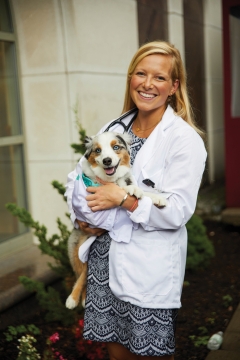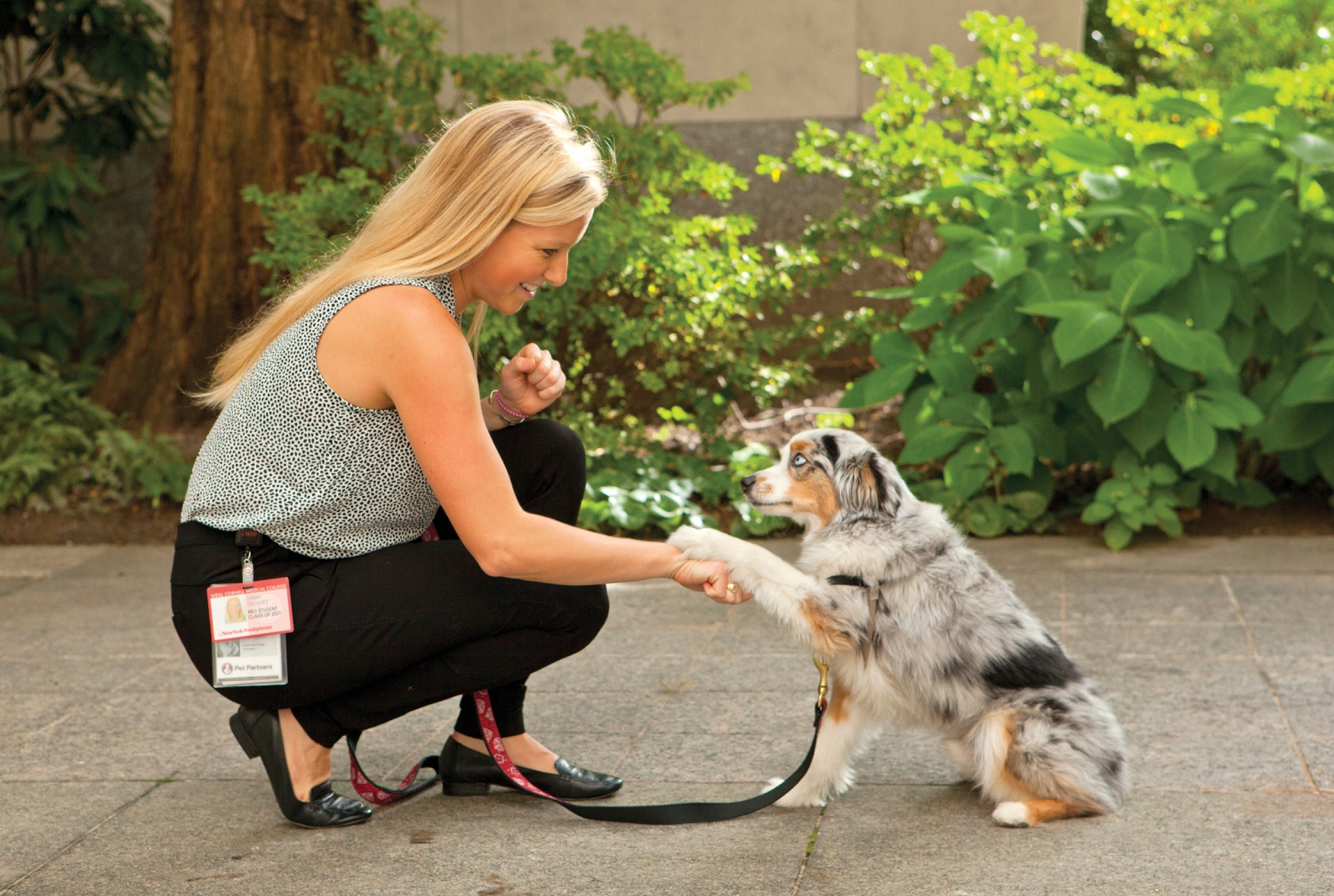Walker Caughey has terrific bedside manner. Patients love him. And he looks adorable with a stethoscope—though with paws instead of fingers, it’d be tough for him to take a pulse.
Boasting silky fur and striking blue eyes, Walker is a three-year-old toy Australian shepherd who belongs to medical student Sarah Caughey ’21. But he’s not just a pet: in a way, he’s a clinical colleague. For the past two years Walker has been a certified therapy dog, bringing comfort (and an impressive repertoire of tricks) to patients, staff and families at medical facilities in three states. “Walker is so people-oriented—he loves to be social,” says Caughey, an Ohio native who adopted him as a puppy when she was a senior at Dartmouth, both to be a pet and to serve as an emotional support animal (ESA) for anxiety related to her migraine headaches. “And he’s very empathetic; he has a tendency to recognize when people are upset. So his whole demeanor is a good fit for pet therapy.”

The pair in matching garb after the 2017 White Coat Ceremony. Photo credit: John Abbott
Caughey studied anthropology and environmental studies as an undergrad, and she’d initially planned on earning a graduate degree in a related field—but, she says, she ultimately decided that the world’s pressing environmental problems rest more in the hands of politicians than researchers. Contemplating what she’d enjoyed about her thesis work—on how the decline of traditional spearfishing in the Dominican Republic has impacted community health—she realized that she craved a career in which she could “connect to people in a meaningful way and problem-solve in a team-based environment with tangible results.” Medicine, the profession of her father and older sister, offered both.
She was drawn to pet therapy, she says, not only because she wanted to do volunteer work and thought Walker would be suited to it, but as a way to clarify her desire to pursue a medical degree. “It made me feel like my personality would fit well in a healthcare scenario—I became much more confident that this was something I could do,” says Caughey. “It gave me an opportunity to become comfortable talking to patients, and it made me realize how important it is to connect with them as people first. It taught me valuable lessons about the kind of physician I want to be.”
Becoming a therapy dog doesn’t require any specialized training (and Walker’s volunteer work is unrelated to his status as an ESA). But he did have to pass a test that comprised basic obedience as well as some behavioral and temperament issues related to a medical environment. He had to demonstrate that he’d remain calm around equipment like wheelchairs and IV poles; that he wouldn’t be flustered by loud noises or heated arguments (since some patients might have cognitive issues); and that he would tolerate the kind of rough petting he might receive from kids or people with motor impairments. “Australian shepherds are a working breed, and pet therapy is a job to Walker for sure,” says Caughey. “It’s overstimulating in a good way—it makes him tired like nothing else can.”
At Dartmouth, Caughey and Walker made weekly appearances at the campus health and wellness center, where he’d hold “office hours,” offering stress relief for students who’d drop by and play with him. They also volunteered at Dartmouth-Hitchcock, the school’s teaching hospital, where they’d greet people at the front entrance and visit patients in the neurology ICU. While living in Baltimore to do her premedical coursework at Goucher College, Caughey brought Walker to Johns Hopkins, where their assignments included visiting the ICU, a pediatric ward and people recovering from transplant surgery. At NewYork-Presbyterian/Weill Cornell Medical Center, they’re making weekly visits to oncology floors. “Pet therapy offers a unique way to connect to patients,” she says. “It allows them to be more vulnerable than they may be willing to be with a doctor. There’s so much anxiety and stress about being in a hospital setting, and Walker offers a different avenue for them to express that.”
In addition to letting patients and families play with and pet him, Walker entertains them with a variety of tricks. He knows “down,” “roll,” “spin,” “dance,” “shake a paw” and—his big finish—“draw-bang,” in which he stands on his hind legs, keels over and plays dead. He even has “business” cards bearing his photo that Caughey hands out—and he’s the star of his own Instagram feed, @wild_wild_walker. “Growing up on a college campus, he’s used to having lots of attention,” she says. “He’s a complete ham.” As Caughey’s official ESA, Walker is considered a service dog and is allowed in public areas and housing. He lives with her in Olin Hall, and Caughey credits their daily rambles along the East River with forcing her to set aside time for herself amid the pressures of medical studies. “My classmates constantly ask if they can babysit him, so it’s definitely an ‘it takes a village’ mentality,” she says. “He’s great stress relief for everyone.”
— Beth Saulnier
This story first appeared in Weill Cornell Medicine, Vol. 17. No. 1

